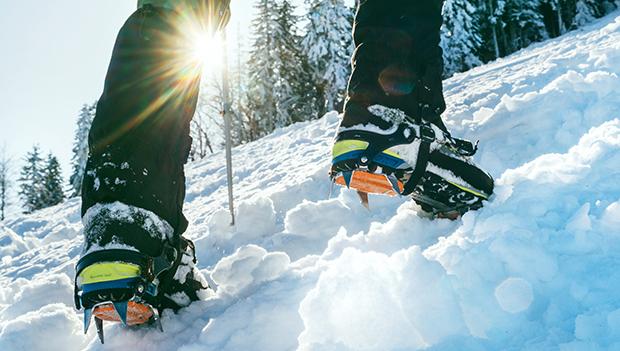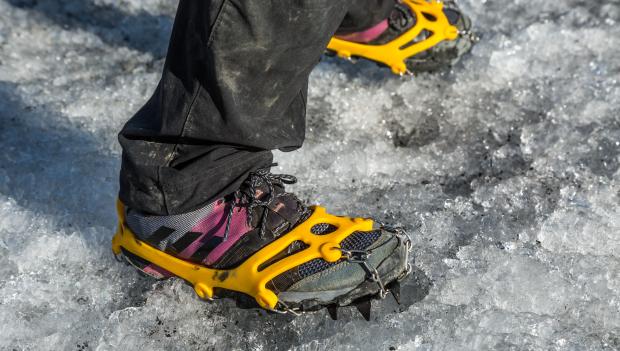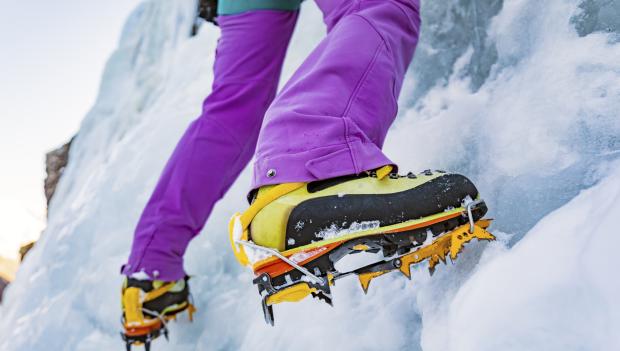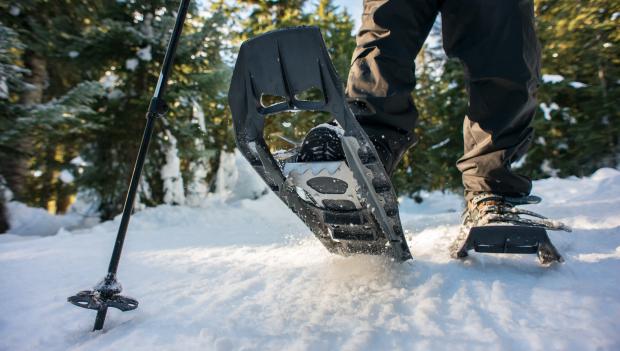
Hiking in winter usually requires extra traction on your feet to prevent slips on ice and snow. There are three types of footwear traction devices for icy or snowy conditions, each appropriate for specific situations: crampons, microspikes, and snowshoes. You may have heard of these traction systems and wondered when to use crampons vs microspikes vs snowshoes. ReserveAmerica wants your next wintry hike to be safe and fun! Learn more about each of these devices and which you should use when hitting a wintry trail.
Once you’re ready to test your gear, check out our 5 Winter Wonderlands to See This Year
Microspikes for Flatter Terrain

- Design: chains with small spikes that are placed around footwear
- Purpose: worn in icy conditions on relatively flat terrain
- Pros: small, easily transportable and low maintenance
The first thing to know when comparing crampons vs microspikes is that microspikes are chains and small spikes that are slipped over your footwear for added traction. The design of microspikes is much like that of chains placed over tires to enhance vehicular traction. The spikes themselves are about ¼ to ½ inch long, giving the wearer the ability to dig into icy surfaces and packed snow. Since the spikes are relatively short and usually placed at the inner portion of the sole, microspikes are preferred for flat terrain or low-angle slopes. The best use case for microspikes is hiking or running in packed snow or icy conditions on relatively even surfaces.
Wearing microspikes does add weight to your feet, potentially tiring you out sooner. It’s recommended to wait to wear microspikes until you hit conditions that require them, rather than wearing them for an entire hike. Fortunately, microspikes are small and easily fit into a bag. Microspikes are also low maintenance, requiring a quick wiping down and then drying for a short period of time.
Crampons for Icy Slopes & Climbs
- Design: foot frames with several large spikes on the bottom
- Purpose: worn on icy high-angle slopes, or for general or technical mountaineering
- Pros: models with less aggressive traction design available for hiking on icing slopes

Recommended: These State Parks Are Even Better in Winter
Snowshoes for Powdery or Deep Snow
- Design: wide and light foot frame that is bound to the foot
- Purpose: worn to float on powdery or deep snow on relatively flat terrain
- Pros: varying foot frame widths for different snow conditions available, as well as snowshoes with crampons for mixed snow-ice conditions

Snowshoes are arguably the outlier in the crampons vs microspikes vs. snowshoes comparison. Snowshoes have a much wider footprint than traditional footwear in order to distribute the hiker’s weight over a large area so they can walk on snow. Where microspikes and crampons are true traction devices, snowshoes are considered a flotation device, quite literally allowing you to float on snow. Snowshoes are, as the name suggests, intended to be worn on the snow and not in icy conditions. Worn on flat or low-angle terrain, snowshoes are ideal for traversing powdery or deep snow on rolling hillsides.
Snowshoes can vary by the size of their footprint and construction materials. When choosing snowshoes, keep in mind that the deeper the snow and the greater your weight (including pack), the longer and wider the snowshoe frames need to be to sustain your flotation over the snow. Conversely, snowshoes that are smaller and narrower are better suited for snow that is compacted, such as on well-traveled winter trails. Additionally, some snowshoes feature incorporated crampons for added traction and use in mixed snow-ice conditions.
Where to Test Your Gear
1. Golden Gate Canyon State Park, Colorado
Open all year long, including during the height of a Rocky Mountain Winter, Golden Gate Canyon State Park has a wide variety of mountainous terrain to try all of your winter weather gear. Located in the heart of the Rockies, the park is beautiful in any season and has 164 campsites, including nine cozy cabins.
2. Lake Wapello State Park, Iowa
Thirteen family cabins are available for rent all year long at Lake Wapello State Park. The rolling wooded hillsides make for a great spot to test out your snowshoes.
3. Monadnock State Park HQ, New Hampshire
Monadnock State Park is a true winter retreat with plenty of snowshoeing opportunities. Ice fishing is also a popular wintertime activity. There are only ten tent sites, to give you a sense of real winter wilderness.
Are you ready for your adventure? Plan your camping trip!